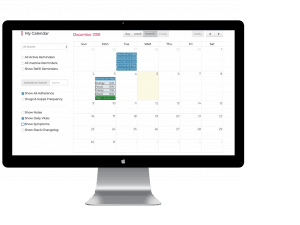![]()
The food that we eat usually shows how our health status looks like. We are what we eat, as well as what we do on a daily basis in life. So if we love fatty and greasy food plus a sedentary lifestyle will only put us on a higher risk of a chronic condition called hypertension. Using a hypertension tracker app can help you manage and prevent hypertension if used properly. Let’s discuss more about Hypertension before delving into the usage of the app for improving your health.
In the world, raised high blood pressure or commonly known as hypertension, accounts for approximately 40% in adults ranging 25 years old and over. This condition causes 7.5 million deaths annually and is considered as a major risk factor for hemorrhagic stroke and coronary heart disease.
For each increment of 20/10mmHg of blood pressure, there are some age groups whose risk of cardiovascular disease doubles significantly. Complications such as renal impairment, retinal hemorrhage, and visual impairment. This is what makes hypertension an inconvenience because it is linked with other life-threatening conditions.
What’s challenging about managing hypertension?
Hypertension entails the intake of various medications but the effects are not seen right away. This is why patients easily get discouraged or even do not make their treatment plans a priority. Yet despite this setback, advanced technology has its way of making things convenient when it comes to taking medications regularly.
CareClinic, a helpful health app can be used as a hypertension tracker app, is one of the best companions for those suffering from hypertension. It has a symptom and activity tracker for hypertension where you can store information on a daily basis. Aside from monitoring hypertension, the app also has a medication reminder option to avoid missing any dose. CareClinic sees to it that you stick to your treatment plan no matter what happens.
This Android and iOS mobile app functions as an effective health diary in which all data can be stored and shared with your specialist. Everything you input in the app will be of great help when the physician creates a treatment plan personalized to your health status.
As you go on with your life experiencing the signs and symptoms, the specialist will be able to adjust the medications and options available. Controlling hypertension requires a change in lifestyle or engage in regular exercise aside from maintenance medications. Eating a healthy and balanced diet such as avoiding too much sodium helps lower down blood pressure levels.
Reducing or even avoiding alcohol and tobacco use has a significant effect on blood pressure levels. All of these activities may be tracked using CareClinic. However, hypertensive patients still need medication all throughout their lives so this health app really comes in handy. Taking medications such as beta blockers, ACE inhibitors and angiotensin II receptor blockers may be tracked by the app efficiently.
This multi-functional app helps a lot in tracking not only the condition but your overall health status. You can record your weight and blood pressure readings aside from the symptoms. Setting exercise goals, as well as diet plans, can also be jotted down in this app. Aside from that, uploading your medication may be done by scanning the bar code on the package. The setting of alarms for different time schedules with the correct dosage can also be done. The app then sends notifications through pop-up windows or vibrating alerts.
Another great feature of this app is that at the end of the month, you can easily print out a health report based on all the data. This report is very important when you visit your specialist. He or she will be able to check your blood pressure readings and symptoms, then create treatment options. Adjustments may be easily made to achieve the best results for your health.
Types of Hypertension
Before diving into using the app, it is best to understand this condition first. There are actually two types of hypertension: primary and secondary. Primary hypertension is raised blood pressure that’s not caused by any other condition. Factors increasing its risk include:
- Old age
- Obesity
- Smoking
- Stress
- High sodium diet
- High intake of alcohol
- Sedentary lifestyle
- Long term sleep deprivation
Secondary hypertension occurs when it is linked with another condition or disease. Unlike the primary type, this condition is caused by numerous factors such as:
- Kidney disease
- Diabetes Mellitus
- Pregnancy
- Obstructive sleep apnea
- Tumors in the adrenal gland
- Hormonal imbalance
- Lupus
- Steroids, birth control pills, cough, and cold medicines
Hypertension, if left untreated, usually result in life-threatening complications. That’s why controlling blood pressure levels is very important to avoid the following:
- Aneurysm
- Stroke
- Heart failure
- Kidney disease
- Dementia
- Loss of vision
What blood pressure level is considered safe?
To answer that question, understanding what blood pressure is prime. It is the force exerted by the blood to the walls of the blood vessels in the body. Blood pressure is determined by the systole and diastole. The systolic pressure refers to how much pressure is inside the blood vessels when the entire heart pumps.
The diastolic pressure, on the other hand, refers to the pressure in the blood vessels when the heart is at rest in between beats. Ideally, healthy blood pressure has a range of 90/60mmHg to 120/80mmHg. According to medical experts, stage 1 hypertension ranges from 130-139/80-89mmHg and stage 2 hypertension is 140/90mHg or higher.
If you happen to belong in between those ranges, there is a greater chance of you developing the disease. This usually happens if you are not actively controlling it. Having raised blood pressure is dangerous because it can lead to stroke, heart failure, atherosclerosis, and even kidney disease. Symptoms are very rare and less obvious making it a silent killer.
Medical professionals can only diagnose it with regular check-ups. Those who happen to be hypertensive usually experience anxiety, sweating and sleeping problems. When you already experience headaches and nose bleeds, then it is already called a hypertensive crisis.
Treatment options for Hypertension
Specialists base their diagnosis after a series of tests to rule out other diseases. Once it is confirmed that you are hypertensive, medication is usually prescribed to control your blood pressure levels. Your doctor checks your family medical history, as well as age, ethnicity and other factors. As the patient, you will have to make sure to adhere to the medication schedule for the treatment to be effective. The following are common blood pressure medications:
- Angiotensin-converting enzyme (ACE) inhibitors such as lisinopril (Zestril), benazepril (Lotensin), and captopril (Capoten). These drugs block the formation of a chemical that narrows blood vessels, thereby relaxing the blood vessels effectively.
- Angiotensin II receptor blockers (ARBs) include candesartan (Atacand) and losartan (Cozaar). These medicines work by blocking the action of the chemical that narrows the blood vessels.
- Calcium channel blockers such as amlodipine (Norvasc) and diltiazem (Cardizem). These drugs relax the muscles of the blood vessels.
- Diuretics like hydrochlorothiazide (Microzide) and chlorthalidone. These drugs actually work on the kidneys and help the body flush out excess sodium and water, which then reduces blood volume.
- Beta blockers such as acebutolol (Sectral) and atenolol (Tenormin). These drugs help lower blood pressure by making the heart beat slower and with less force. They are not as effective as a stand-alone but are often prescribed in conjunction with other drugs.
Drugs are not the only solution because changing your lifestyle can work wonders on your health. Yes, doctors prescribe medications but these are also proven to work well if you help your body. One of which is eating food less in salt. Fruits and vegetables are very important and considered less in fat.
Having regular exercise also boosts the immune system and prevent a person from being overweight. Avoiding alcohol intake also helps in lowering blood pressure as well as stopping cigarette smoking. Caffeine is also linked with hypertension so reducing intake would be beneficial to your health. Lastly, sleep is very important for a healthy life. Getting at least six hours of bedtime helps in lowering blood pressure levels.
Hypertension Tracker App for Managing Hypertension Triggers

As patients, you need to take full responsibility for your medication and therapy. Doctors can only suggest, prescribe and diagnose, but it is still up to you to man up and adhere to the medication schedule. Getting discouraged with the results will not help during the treatment phase. Don’t stop taking the prescribed medicines unless your specialist tells you to.
Medications that are meant to regulate blood pressure levels are to be taken long-term, at the right time and dosage. So this is where CareClinic comes in.
The hypertension tracking app is tailored to each patient’s medical needs and has a built-in medication database that works for any medicine. This hypertension app sends notifications when it is time to take your medication. The dosage can also be stored by using the medication’s bar code. Aside from medication reminders, the app also records lifestyle changes, diet and blood pressure readings.
CareClinic sees to it that everything comes handy when you are scheduled to visit the doctor. The outstanding features of this app not only reminds you of your treatment plan, but it also encourages you to manage your condition well by having an active lifestyle and eating a healthy, balanced diet.
If you need help managing hypertension, use CareClinic to manage your health and discover correlations and triggers that can help you. To get started using the CareClinic app, click here.
Learn more about using CareClinic to manage your hypertension by watching our short video:


